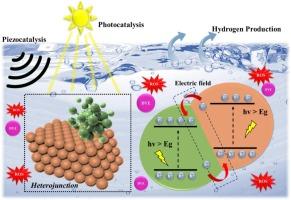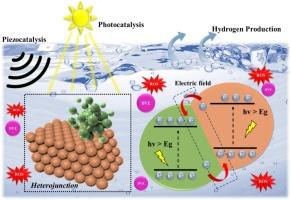Recent advances in piezo-photo heterojunction: a review on dual catalytic function for wastewater remediation and simultaneous hydrogen generation.
IF 23.5
1区 化学
Q1 CHEMISTRY, INORGANIC & NUCLEAR
引用次数: 0
Abstract
Water pollution and the energy crisis have become a persistent threat to modern civilization. Organic dyes, pharmaceuticals, pathogens, pesticides, fertilizers, etc., disrupt the ecological balance and create several health hazards to humankind. On the other hand, the depletion of non-renewable energy sources like coal, petroleum, etc., is also affecting modernization, the environment, and industrial production. In the last few decades, piezo catalysis and photocatalysis have emerged as successful and promising advanced oxidation processes to degrade such contaminants from wastewater and catalytic energy generation, like green H2 evolution. The limitations, like high reaction time, recombination rate of photogenerated electron-hole pair, energy efficiency, etc., of such catalytic systems motivated the researchers to advance the systems by composite formation, metal ion implantation, heterostructure development, etc. This article delves into the piezo-photo heterostructure and its augmented multi-dynamic catalytic efficacy and green hydrogen generation. The sandwich structure of heterostructure enhances the catalytic performances by augmented reactive oxygen species (ROS) generation, lowering recombination rate, and enhancing the stability of the catalyst as well as H2 evolution. This article also includes the underlying mechanism of mechanical stress-driven piezo-catalysis and photo-impulse-generated photocatalysis, and different types of heterostructure systems and their electronic structures. The fabrication strategies, operational conditions, and performance matrix of different types of heterostructures and their challenges in terms of stability, real-world applicability, and recent and future progress are also discussed in this article, which validates the environmental remediation and clean energy generation capability of this multifunctional system.


压电-光异质结在废水修复和同时制氢中的双重催化作用研究进展。
水污染和能源危机已经成为现代文明的持久威胁。有机染料、药品、病原体、农药、化肥等,破坏生态平衡,对人类健康造成多重危害。另一方面,煤炭、石油等不可再生能源的枯竭也在影响着现代化、环境和工业生产。在过去的几十年里,压电催化和光催化已经成为一种成功的、有前途的高级氧化工艺,用于降解废水中的污染物和催化能源生产,如绿色H2演化。这种催化体系存在反应时间长、光生电子-空穴对复合率高、能量效率低等局限性,促使研究人员通过复合材料形成、金属离子注入、异质结构发展等方法来推进体系的发展。本文对压电光异质结构及其增强的多动态催化效能和绿色制氢进行了深入研究。异质结构的夹层结构通过增强活性氧(ROS)的生成,降低重组速率,增强催化剂的稳定性和析氢能力,提高了催化性能。本文还介绍了机械应力驱动的压电催化和光脉冲产生的光催化的基本机理,以及不同类型的异质结构体系及其电子结构。本文还讨论了不同类型异质结构的制备策略、运行条件和性能矩阵,以及它们在稳定性、实际适用性和近期和未来进展方面面临的挑战,从而验证了该多功能系统的环境修复和清洁能源发电能力。
本文章由计算机程序翻译,如有差异,请以英文原文为准。
求助全文
约1分钟内获得全文
求助全文
来源期刊

Coordination Chemistry Reviews
化学-无机化学与核化学
CiteScore
34.30
自引率
5.30%
发文量
457
审稿时长
54 days
期刊介绍:
Coordination Chemistry Reviews offers rapid publication of review articles on current and significant topics in coordination chemistry, encompassing organometallic, supramolecular, theoretical, and bioinorganic chemistry. It also covers catalysis, materials chemistry, and metal-organic frameworks from a coordination chemistry perspective. Reviews summarize recent developments or discuss specific techniques, welcoming contributions from both established and emerging researchers.
The journal releases special issues on timely subjects, including those featuring contributions from specific regions or conferences. Occasional full-length book articles are also featured. Additionally, special volumes cover annual reviews of main group chemistry, transition metal group chemistry, and organometallic chemistry. These comprehensive reviews are vital resources for those engaged in coordination chemistry, further establishing Coordination Chemistry Reviews as a hub for insightful surveys in inorganic and physical inorganic chemistry.
 求助内容:
求助内容: 应助结果提醒方式:
应助结果提醒方式:


